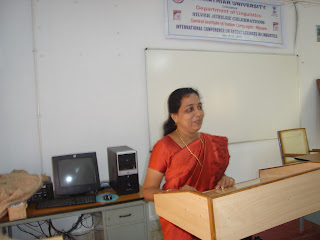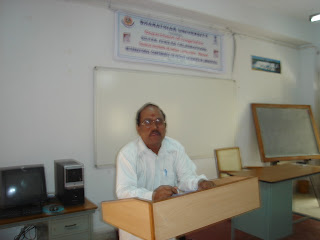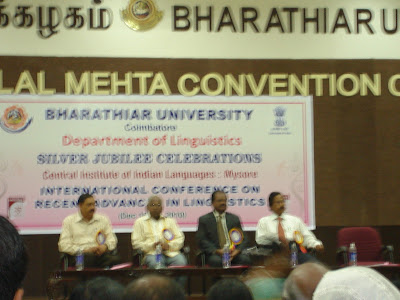Courtesy: Published in the proceedings of International Conference on Recent Advances in Linguistics (ICRAL), held in the Department of Linguistics, Bharathiar University, Coimbatore.
TAMIL LANGUAGE THROUGH THE AGES
(Early Period to Later Sangam Period)
Dr. A. Kamatchi
Assistant Professor
CAS in Linguistics
Annamalai University
Introduction
In the world, there was/is no language without changes. There have been changes being taken place automatically in every language time to time, of course. In the same way, Tamil, too, faced many changes through the ages from early period to contemporary period. Historically speaking, there are languages which have gone not to exist in the world only because of not accepting the changes. There were changes in writing system of Tamil, phonology, Morphology, syntax and semantics. Thus the present paper attempts to highlight the categories which had gotten the changes in the components of the language through the ages from early period to the later Sangam period.
Changing in Writing System
There were many changes taken place in the writing system from the early stage to present day language. Accordingly, for instance, there were no symbols for short vowels, e and o. Only after four or five centuries later than the early period, the symbols of short vowels of them were distinguished by getting dot on their respective symbols of long vowels to differentiate from the long to the short vowels, according to Brahmi Tamil.
While we are talking about the Brahmi scripts, it is important to note that they are divided into two kinds of Brahmi – Northern Brahmi and Southern Brahmi. The latter kind is further subdivided into two – early Tamil Brahmi and later Tamil Brahmi.
Short and Long Vowels of e and o
It is noticed that there has been no primary symbol for the short vowel o throughout the period of Brahmi Tamil and however, there has been dot on the symbol to represent the secondary vowel of o in the later Brahmi Tamil period of 3rd century A.D. As far as the symbol of short vowel e is concerned, the symbol for the e is not attested in the early Brahmi Tamil period and also until the period of 3rd century A.D. Its attestation is noticed only in the 4th century A.D. Coming to primary and secondary symbols, the former one is attested only in the period of 4the century A.D. whereas the latter one occurred in the period of 5th century A.D. However, in the medieval period, the system of putting the dot on the symbol to distinguish the long versus short was missing, of course. However, the context alone determines the long and the short vowels of e and o.
Dipthong au and ai
Linguistically speaking, in both the early and later Tamil Brahmi, there was no symbol for the dipthong au. In the same way, there has been no primary symbol for dipthong ai until the period of 6th century A. D., according to the paleography evidences although its secondary symbol is attested even in the early Brahmi period of 3rd century B.C.
Consonants
No language in the world gets dot on the symbols to represent consonant category in the writing system. But such system is available only in Tamil. Putting the dot on the symbols was developed only after the period of 2nd century A.D. in Tamil language. Though such type of system had existed in the language of Tamil in the early inscriptional Tamil, this system has not prevailed in mediaeval period as well as until the nineteenth century A.D. The reason why this system is missing in these periods may be only because the palm leaves might have damaged when one could put the dot on it. Therefore in these periods, the representation of consonant was determined according to the context identified by the word which means its meaning.
Phonology
Phonemes and Combination of Consonant and Vowel in Distribution
The consonant y occurs only with the vowel aa in initial position in Tolkaappiyam period , according to Tolkaappiyam sutras. But, in addition to this vowel, the vowels such as a and uu also began to occur in Sangam Tamil, as in the examples like yavanar and yuukam, respectively. Considering the later Sangam period, the vowel oo also occurs with the consonant y in this period, as in the case of yookam.
As far as the distribution of c is concerned, the phoneme c occurs with all the vowels except the vowels such as a, ai and au in the initial position. Nonetheless, in Sangam period, its occurrence was also with the vowels a and ai. In other words, the vowel au alone did not occur with the consonant, c, in the initial position. Concerning the distribution of ñ, in the initial position, this consonant occurs only with the vowels aa, e and o in Tolkaappiyam period. In Sangam period, however, the consonant ñ occurs also with the vowels a and i in addition to the vowels which have been mentioned earlier.
Until the Sangam stage, there had been no word with initial consonant r. From the later Sangam period onwards, the word with initial r started to occur in Tamil, as in iraaman and iraavaNan. Actually, such type of words was borrowed from other languages and tamilized in the language. Nonetheless, this type of words always occurs with the vowel, i, in initial. The reason why these words are getting this vowel in the initial position is that as pointed out earlier, the structure of early Tamil did not allow the consonant r in the initial position of the word and also it should maintain the language structure. At the same time, the language should fulfill its needs so that the language should accept the words borrowed from the other languages as well.
In the same way, the lateral consonant l is not allowed to enter into the initial position until the period of Sangam age. From the later Sangam period onwards, its initial position was gradually permitted to use it in the initial position. As a result, we see the words like lookam in the later Sangam texts.
Among the eighteen consonants in Tamil, ten consonants – N, n, m, ṉ, y, r, l, v, l, and L - occur in final position of the word, according to Tolkaappiyam. All the same, in Sangam period, one more consonant, ñ, not occurring in the final position in Tolkaappiyam period, started to occur in this position in Sangam period.
Morphology
Tense
In Tolkaappiyam period, there are three tenses – past, present and future – according to Tolkaappiyam sutras. Though it mentions three tenses, it does not point out what are the tense markers in Tamil in Tolkaappiyam period. But, in contrast to this statement made by Tolkaappiyar, there are only two tenses – past and nonpast – in Sangam period, according to the findings by modern linguists working in the field of classical Tamil. When we go to Brahmi Tamil, it is evidently pointed out that the past tense markers are elaborately attested in the Brahmi Tamil but only one occurrence with future marker is attested in this corpus. Although modern linguists pointed out that only two tenses – past and nonpast – occur in Sangam period, the very rare occurrence of present tense marker is, however, attested in three times in Narrinai. Though the number of occurrence in NaRRinai is three, its finite verb form is only one, i.e. aakinRatu, ‘becomes it’. But in ParipaaTal text, this marker comes along with other verb root, ceer, like ceerkinRa ‘which joins’, the occurrence of which is the adjectival participle as far as its structure is concerned. There are two markers – kiR and kinR – to denote the present time in the later Sangam period. Nevertheless, both the markers occur in Manimekalai text whereas the form -kinR- alone is attested in cilappatikaaram text, but there is an absence of -kiR- marker in this text. It is peculiar to be noted that the form –kuv-, which was not mentioned by Tolkaappiyam and not attested in the later Sangam period, existed in Sangam period to denote the concept of nonpast in general and future in particular.
Case and Postposition
As far as the case markers are concerned, the marker –aal was developed to represent the instrumental case in the later Sangam period. Furthermore, another case marker –uTaya is also developed to denote the meaning of the genitive case in this period. In the same way, from this period onwards, the new concept of postposition began to develop in the language and the postposition markers, such as koNTu to denote the meaning of instrumental case and uTan to mean the sociative case, started to exist in the first time in the language in this period.
Pronoun
The absence of the first person is noticed in the period of Brahmi Tamil. The form yaam is pointed out by Tolkaappiyam. This is also attested in Sangam and later Sangam periods. But the form naan, the equalent form of yaan, is attested only one time in ParipaaTal of Sangam texts and later it was well developed in the period of later Sangam. As far as the second person plural is concerned, the forms niir and niivir are clearly pointed out by Tolkaappiyam. But in Sangam period niir and niiyir are attested. As far as the oblique form of second person plural is concerned, the form num, but not um, is attested in Sangam Tamil. The form um, which is derived from num after loosing the initial phoneme in num, started to occur in ParipaaTal where it is available in only one place. Nevertheless, its occurrences have increased in the later Sangam period. In the same manner, there was a form nin for representing the second person singular in Sangam period and however, instead of nin, the form un started to enter into the texts of the later Sangam period.
Place Adverb
The interrogative place adverb yaaŋku started to become eŋku only in the later Sangam period. In other words, it can be explained that the long vowel in the initial syllable started to get shortening from this period. From this period onwards, the initial long vowels of demonstrative place adverbs such as aaŋku and iiŋku become shortened like aŋku and iŋku, respectively.
Demonstrative
There are three demonstratives – a, i, and u – enumerated by Tolkaappiyam. The same forms are attested in Sangam period. But in the later sangam period, in addition to these demonstratives, they were developed to demonstrative pronoun status like anta and inta. Nonetheless, though the remote and proximate demonstrative pronouns were attested, we are not able to find out the intermediate demonstrative pronoun in the later Sangam period. Further, it is to be notably pointed out that the form anta and inta ate attested in Manimeekalai, but the latter form only occurs in Cilappatikaaram.
Lexicon
Many words with initial y plus aa which existed in Tolkaappiyam period began to lose the initial consonant y from these words, rarely in Sangam period and widely in the later Sangam Period. For instance, one can exemplify the words such as yaaTu >aaTu, yaamai>aamai, yaaRu>aaRu and so on. The form ellaam, which occurs only with nonhuman noun in Tolkaappiyam period and in Sangam period, started to go with the human noun as well from the later Sangam period. It is evident to say example like antaNar ellaam, that is the only one example (attested in the later Sangam period) which started to violate the rules of the language structure that prevailed in the early periods.
Conclusion
For this study, only the random samples have been selected and analyzed in this paper. If this methodology is used to whole texts of composed and published materials produced in time to time in different periods in the language, a lot of things could definitely be unearthed through the study. Of course, it is the pioneer attempt in this field. We have a lot of facilities nowadays. Using these facilities we can easily find out what are the grammatical items available or not available in the texts belonging to a particular period and/or different periods. Further, it is noteworthy to mention that every text in medieval Tamil should be typed and supplied to the computer. Of course, for this laborious work, definitely it needs not only man power to do the work but also the huge amount of funds. Otherwise, we cannot achieve this task. One problem we are going to face is that feeding the texts available in Sangam period or the later Sangam period is not a problem. However, it is not easy task when we try to feed the texts pertaining to the mediaeval period as well as the modern period texts. The reason is that there are numerous text materials available in the language and everything should be computerized for this study and then we have to start such work so that this study will achieve the tremendous task in this field, of course. Once we complete such a work, I hope, it will be the pioneer one in this field, no doubt at all.
Bibliography
Agesthialingom, S. 1979. A Grammar of Old Tamil with reference to PatiRRuppattu, Annamalai University Publication : Annamalai Nagar.
Anjali Annabai. 1980. Tolkappiyam and the Language of Manimekalai, Ph. D. Thesis, Madurai Kamaraj University.
Israel, M. 1973. The Treatement of Morphology in Tolkappiyam. Madurai : Madurai University Publications.
Mahadevan, I. 1970. Tamil-Brāhmi Inscriptions. Madras : Tamilnadu State Development of Archaeology.
Mahadevan, I. 2003. Early Tamil Epigraphy (from the earliest times to the Sixth century A.D.). Chennai : Cre-A & Cambridge : Harvard University.
Meenakshisundaran, T. P.1965. A History of the Tamil Language. Poona : Deccan College Post Graduate and Research institute.
Sakthivel, S. 1984. Tamil moli varalaaRu, Manivasakar patippakam, Chennai.
Subramanya Sastri, P.S.S. 1979. Tolkappiyam – Collatikāram with An English Commentary. Annaalai Nagar : Annamalai University. (First published in 1945)
------------- 1955. Tolkappiyam-eluttatikāram. Commentary by Naccinārkkiniyar. Madras : Kalakam Edition.
&&&@@@&&&



















